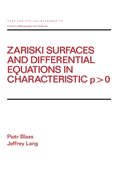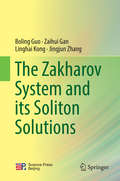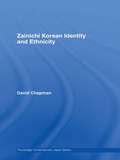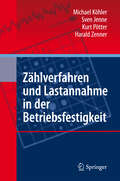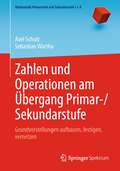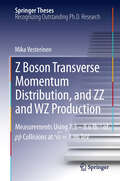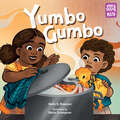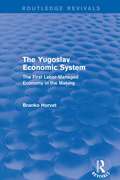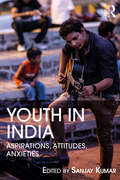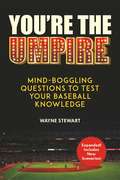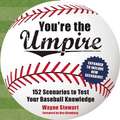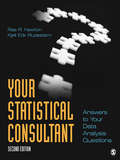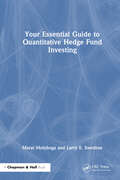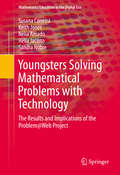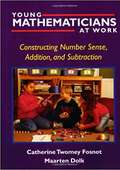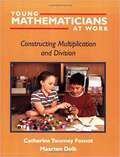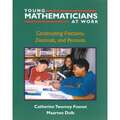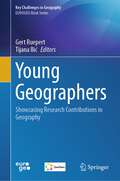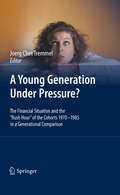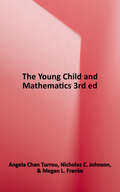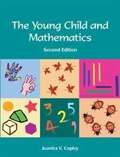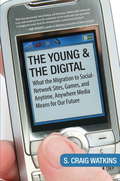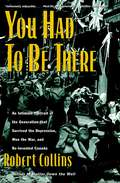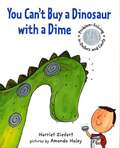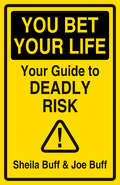- Table View
- List View
Zariski Surfaces and Differential Equations in Characteristic P < O (Chapman And Hall/crc Pure And Applied Mathematics Ser. #106)
by Piotr BlassThis book represents the current (1985) state of knowledge about Zariski surfaces and related topics in differential equations in characteristic p > 0. It is aimed at research mathematicians and graduate and advanced undergraduate students of mathematics and computer science.
The Zakharov System and its Soliton Solutions
by Boling Guo Zaihui Gan Linghai Kong Jingjun ZhangThis book focuses on the theory of the Zakharov system in the context of plasma physics. It has been over 40 years since the system was first derived by V. E. Zakharov - and in the course of those decades, many innovative achievements with major impacts on other research fields have been made. The book represents a first attempt to highlight the mathematical theories that are most important to researchers, including the existence and unique problems, blow-up, low regularity, large time behavior and the singular limit. Rather than attempting to examine every aspect of the Zakharov system in detail, it provides an effective road map to help readers access the frontier of studies on this system.
Zainichi Korean Identity and Ethnicity (Routledge Contemporary Japan Series #10)
by David ChapmanShedding light on contemporary Japanese society in an international context, Japanese-Korean relations and modern day notions of a multicultural Japan, this book addresses the broad notions and questions of citizenship, identity, ethnicity and belonging through investigation of Japan’s Korean population (zainichi). Despite zainichi Korean existence being integral to, and interwoven with, recent Japanese social history, the debates and discussions of the Korean community in Japan have been largely ignored. Moreover, as a post colonial context, the zainichi Korean situation has drawn scant attention and little investigation outside of Japan. In Zainichi Korean Ethnicity and Identity David Chapman seeks to redress this balance, engaging with recent discourse from within Japan’s Korean population. By taking a close look at how exclusion, marginalisation and privilege work, the book brings insight into the mechanisms of discrimination, and how discourse not only marginalizes individuals and groups, but also how it can create social change and enhance the sense of self. This book will be of interest to students and scholars of Asian studies and of Japanese and Korean politics, culture and society, but also to those with a broader interest in migration studies and the study of identity and ethnicity.
Zählverfahren und Lastannahme in der Betriebsfestigkeit
by Kurt Pötter Michael Köhler Sven Jenne Harald ZennerDie Betriebsfestigkeitsprüfung von Bauteilen ist u. a. erforderlich, um ihre Lebensdauer zu berechnen. Dazu werden verschiedene Methoden angewendet, die jeweils Vor- und Nachteile aufweisen. Bei schwingender Beanspruchung ist die Methode der Zählverfahren geeignet. Sie wird in dem vorliegenden Buch beschrieben und bewertet. Die Autoren bieten einen kompakten Überblick über den Stand der Technik und liefern Empfehlungen für die Anwendung in der Praxis.
Zahlen und Operationen am Übergang Primar-/Sekundarstufe: Grundvorstellungen aufbauen, festigen, vernetzen (Mathematik Primarstufe und Sekundarstufe I + II)
by Axel Schulz Sebastian WarthaWelche arithmetischen Kompetenzen sollen Lernende am Ende der Primarstufe aufgebaut haben, um ein fundiertes Weiterlernen zu ermöglichen? Welche Hürden gibt es dabei und wie können sie überwunden werden? An welchen Modellen können Grundvorstellungen aufgebaut werden und wie können sie im weiteren Lernprozess aufgegriffen werden? Wie können Lehrkräfte den Übergang Primar- zu Sekundarstufe bestmöglich gestalten? An der Schnittstelle stehen zentrale arithmetische Inhalte, die hier aus der Perspektive der Primarstufe (welche Kompetenzen sind unverzichtbar und wie können sie aufgebaut werden) und der der Sekundarstufe (welche Aspekte gilt es zu wiederholen, woran kann und soll angeknüpft werden) diskutiert werden:„Große“ Zahlen: Grundvorstellungen aufbauen, Zahlen als Mengen und Positionen darstellen und vorstellen, Stellenwertverständnis erweitern, Beziehungen aufbauen und nutzenAddition und Subtraktion im Zahlenraum über 100: Operationsvorstellungen aufbauen, Rechenstrategien diskutieren und darstellen, schriftliche Algorithmen anschaulich besprechenMultiplikation und Division: Operationsvorstellungen aufbauen, Zusammenhänge zwischen beiden Operationen nutzen, Rechenstrategien im Zahlenraum bis und über 100 anschaulich diskutieren, schriftliche Verfahren an Modellen verstehenZahlen in Bruch- und Dezimalschreibweise: Grundvorstellungen aufbauen, Zahlbeziehungen verstehen und nutzen, Stellenwertverständnis ausbauen, Zahlen in Kontexten verwenden Alle Inhalte werden unter dem Aspekt der Prozessorientierung behandelt. Hierzu werden Impulse zur Kommunikation über Rechenwege, Zahlen und Zahlbeziehungen vorgeschlagen,Ideen für Argumentationsanlässe beim Arbeiten mit Zahlen und Operationszeichen vorgestellt,nur wenige, dafür sehr tragfähige Modelle thematisiert, die das Darstellen und Vorstellen von Zahlen und Operationen ermöglichen. Insbesondere wird aufgezeigt, wie die Verwendung von vielseitig einsetzbaren, konkreten Arbeitsmitteln und daraus entwickelten mentalen Modellen eine Konstante im Lernweg der Kinder und Jugendlichen am Übergang zwischen den Schulstufen sein kann.
Z Boson Transverse Momentum Distribution, and ZZ and WZ Production
by Mika VesterinenThis work develops novel data analysis techniques enabling aspects of the Standard Model of particle physics to be tested with unprecedented precision using data from the DZero experiment at the high energy "Tevatron" proton-antiproton collider at Fermilab, Chicago. Vesterinen's measurements of the transverse momentum of Z bosons using the novel variable φ* have exposed deficiencies in the current state-of-the-art theoretical predictions for vector boson production at hadron colliders. These techniques are now being used in the experiments at CERN's Large Hadron Collider (LHC) and have stimulated considerable interest in the theoretical particle physics community. Furthermore, Vesterinen's measurements of the cross sections for the production of pairs of vector bosons (WZ and ZZ) are to date the most precise ever made.
Yumbo Gumbo (Storytelling Math)
by Keila V. DawsonCelebrate diversity, math, and the power of storytelling!Annabelle's grandparents are finally going to teach her how to cook gumbo! But the family can't agree on what type of gumbo to make. They vote for their favorite, but the vote results in a tie. Now what? A playful exploration of data and social-emotional reasoning, featuring Louisiana Creole characters and a glossary of Louisiana Creole words.Storytelling Math celebrates children using math in their daily adventures as they play, build, and discover the world around them. Joyful stories and hands-on activities make it easy for kids and their grown-ups to explore everyday math together. Developed in collaboration with math experts at STEM education nonprofit TERC, under a grant from the Heising-Simons Foundation.
The Yugoslav Economic System (Routledge Revivals): The First Labor-Managed Economy in the Making
by Branko HorvatFirst published in 1976, this book traces the development of the Yugoslav economy from the end of the Second World War to the beginning of 1975, which the author argues was a highly productive era of social innovation. Drawing on personal experience of the Revolution, the Partisan Liberation War and his time as a member of the Federal Planning Board as well as a comprehensive array of written sources, the author attempts to understand the development process, compare policy proclamations with achieved results, study the theories and ideas that led a to certain policy, distinguish the economic and political ingredients in decision making and analyses the causes of success and failure.
Youth in India: Aspirations, Attitudes, Anxieties
by Sanjay KumarThis book explores the attitudes, anxieties and aspirations of India’s burgeoning young population in a globalised world. Drawing upon time-series survey data of the Indian youth aged between 15 and 34 years across 19 Indian states, it provides key insights into a range of themes along with an overview of the changing trends and patterns of their behaviour. The volume examines the job preferences of the Indian youth, their career priorities and opinions on reservations in employment and education sectors. It measures their degree of political participation and studies their attitude regarding political issues. It looks at aspects relating to their social and cultural contexts, preferences and practices, including lifestyle choices, consumption habits and social customs such as marriage, as they negotiate between tradition and modernity. Further, it discusses the anxieties and insecurities that the youth face, their mental health and their experiences of social discrimination. The essays here offer an understanding of a critical demographic and shed light on the challenges and opportunities that the Indian youth confront today. Lucid, accessible and empirically grounded, this volume will be useful to scholars and researchers of sociology, political sociology, political studies, youth psychology and anthropology as well as policymakers, journalists and the interested general reader.
You're the Umpire: Mind-Boggling Questions to Test Your Baseball Knowledge
by Wayne StewartDo you think you have what it takes to be a Major League umpire? Well, now you can test your knowledge of the game with Wayne Stewart’s You’re the Umpire. Divided into three sections, this unusual handbook, now in its third edition, offers Routine Calls, which deal with scenarios and rules that typically come up in games and deal with clear-cut rules—fair and foul, strike zone questions, and the like. The next section, Basic Situations, deals with umpiring matters and rules that are just a bit more unusual or, for the casual fan, obscure. Interference and obstruction calls, for example, don’t come up too often, but they remain standard stuff involving rules that umps and many fans know quite well. In the final section, Obscure Rules and Situations, you will be presented with what many baseball people call “knotty” problems. Here, you will be asked questions involving the complex infield fly rule and other arcane matters. This section, then, is the ultimate test of your umpiring skills and knowledge. Most of the situations in You’re the Umpire come from real games, such as the time a fastball from Randy Johnson killed a bird in flight and what the umps did regarding that pitch, but some scenarios are made up to illustrate specific points or rules. Test yourself against your friends or against the iconic baseball rulebook. It’s a challenge and it’s fun.
You're the Umpire: 152 Scenarios to Test Your Baseball Knowledge
by Wayne Stewart Ron BlombergDo you think you have what it takes to be a Major League umpire? Well, now you can test your knowledge of the game with Wayne Stewart’s You’re the Umpire.Divided into three sections, this unusual handbook, now in its second edition, offers "Routine Calls," which deal with scenarios and rules that typically come up in games and deal with clear cut rules-fair and foul, strike zone questions, and the like. The next section, "Basic Situations," deals with umpiring matters and rules that are just a bit more unusual or, for the casual fan, obscure. Interference and obstruction calls, for example, don’t come up too often, but they remain standard stuff involving rules that umps and many fans know quite well. In the final section, "Obscure Rules and Situations," you will be presented with what many baseball people call "knotty” problems. Here, you will be asked questions involving the complex infield fly rule and other arcane matters. This section, then, is the ultimate test of your umpiring skills and knowledge.Most of the situations in You’re the Umpire come from real games, but some scenarios are made up to illustrate specific points or rules. Test yourself against your friends or against the famously iconic baseball rulebook. It’s a challenge and it’s fun.Skyhorse Publishing, as well as our Sports Publishing imprint, are proud to publish a broad range of books for readers interested in sports-books about baseball, pro football, college football, pro and college basketball, hockey, or soccer, we have a book about your sport or your team.Whether you are a New York Yankees fan or hail from Red Sox nation; whether you are a die-hard Green Bay Packers or Dallas Cowboys fan; whether you root for the Kentucky Wildcats, Louisville Cardinals, UCLA Bruins, or Kansas Jayhawks; whether you route for the Boston Bruins, Toronto Maple Leafs, Montreal Canadiens, or Los Angeles Kings; we have a book for you. While not every title we publish becomes a New York Times bestseller or a national bestseller, we are committed to publishing books on subjects that are sometimes overlooked by other publishers and to authors whose work might not otherwise find a home.
Your Statistical Consultant: Answers to Your Data Analysis Questions
by Dr Rae R. Newton Dr Kjell Erik RudestamAlthough many graduate students and researchers have had course work in statistics, they sometimes find themselves stumped in proceeding with a particular data analysis question. In fact, statistics is often taught as a lesson in mathematics as opposed to a strategy for answering questions about world[?], leaving beginning researchers at a loss for how to proceed. In these situations, it is common to turn to a statistical expert, the "go to" person when questions regarding appropriate data analysis emerge. Your Statistical Consultant is an authentic alternative resource for describing, explaining, and making recommendations regarding thorny or confusing statistical issues. Written to be responsive to a wide range of inquiries and levels of expertise, this book is flexibly organized so readers can either read it sequentially or turn directly to the sections that correspond to their concerns and questions.
Your Essential Guide to Quantitative Hedge Fund Investing
by Marat Molyboga Larry E. SwedroeYour Essential Guide to Quantitative Hedge Fund Investing provides a conceptual framework for understanding effective hedge fund investment strategies. The book offers a mathematically rigorous exploration of different topics, framed in an easy to digest set of examples and analogies, including stories from some legendary hedge fund investors. Readers will be guided from the historical to the cutting edge, while building a framework of understanding that encompasses it all. Features Filled with novel examples and analogies from within and beyond the world of finance Suitable for practitioners and graduate-level students with a passion for understanding the complexities that lie behind the raw mechanics of quantitative hedge fund investment A unique insight from an author with experience of both the practical and academic spheres.
Youngsters Solving Mathematical Problems with Technology
by Susana Carreira Keith Jones Nélia Amado Hélia Jacinto Sandra NobreThis book contributes to both mathematical problem solving and the communication of mathematics by students, and the role of personal and home technologies in learning beyond school. It does this by reporting on major results and implications of the Problem@Web project that investigated youngsters' mathematical problem solving and, in particular, their use of digital technologies in tackling, and communicating the results of their problem solving, in environments beyond school. The book has two focuses: Mathematical problem solving skills and strategies, forms of representing and expressing mathematical thinking, technological-based solutions; and students´ and teachers´ perspectives on mathematics learning, especially school compared to beyond-school mathematics.
Young Mathematicians At Work: Constructing Number Sense, Addition, And Subtraction
by Catherine Twomey Fosnot Maarten DolkIn our efforts to reform mathematics education, we've learned a tremendous amount about young students' strategies and the ways they construct knowledge, without fully understanding how to support such development over time. The Dutch do. So, funded by the NSF and Exxon, Mathematics in the City was begun, a collaborative inservice project that pooled the best thinking from both countries. In Young Mathematicians at Work, Catherine Fosnot and Maarten Dolk reveal what they learned after several years of intensive study in numerous urban classrooms. The first in a three-volume set, Young Mathematicians at Work focuses on young children between the ages of four and eight as they construct a deep understanding of number and the operations of addition and subtraction. Rather than offer unrelated activities, Fosnot and Dolk provide a concerted, unified description of development, with a focus on big ideas, progressive strategies, and emerging models. Drawing from the work of the Dutch mathematician Hans Freudenthal, they define mathematics as "mathematizing" - the activity of structuring, modeling, and interpreting one's "lived world" mathematically. And they describe teachers who use rich problematic situations to promote inquiry, problem solving, and construction, and children who raise and pursue their own mathematical ideas. In contrast to other books on math reform, Young Mathematicians at Work provides a new look at the teaching of computation. It moves beyond the current debate about algorithms to argue for deep number sense and the development of a repertoire of strategies based on landmark numbers and operations. Sample minilessons on the use of the open number line model are provided to show you how to support the development of efficient computation.
Young Mathematicians At Work: Constructing Multiplication And Division
by Catherine Twomey Fosnot Maarten DolkIn our efforts to reform mathematics education, we've learned a tremendous amount about young students' strategies and the ways they construct knowledge, without fully understanding how to support such development over time. The Dutch do. So, funded by the NSF and Exxon Mobil, Mathematics in the City was begun, a collaborative inservice project that pooled the best thinking from both countries. In Young Mathematicians at Work, Catherine Fosnot and Maarten Dolk reveal what they learned after several years of intensive study in numerous urban classrooms. In this second volume in a series of three, Fosnot and Dolk focus on how to develop an understanding of multiplication and division in grades 3-5. Their book: describes and illustrates what it means to do and learn mathematics provides strategies to help teachers turn their classrooms into math workshops that encourage and reflect mathematizing examines several ways to engage and support children as they construct important strategies and big ideas related to multiplication takes a close look at the strategies and big ideas related to division defines modeling and provides examples of how learners construct modelswith a discussion of the importance of context discusses what it means to calculate using number sense and whether or not algorithms should still be the goal of computation instruction describes how to strengthen performance and portfolio assessment emphasizes teachers as learners by encouraging them to see themselves as mathematicians.
Young Mathematicians at Work: Constructing Fractions, Decimals, and Percents
by Catherine Twomey Fosnot Maarten DolkIn our efforts to reform mathematics education, we've learned a tremendous amount about young students' strategies and the ways they construct knowledge, without fully understanding how to support such development over time. The Dutch do. So, funded by the National Science Foundation and ExxonMobil, Mathematics in the City was begun, a collaborative inservice project that pooled the best thinking from both countries. In Young Mathematicians at Work, Catherine Fosnot and Maarten Dolk reveal what they learned after several years of intensive study in numerous urban classrooms. In this third volume in a series of three, Fosnot and Dolk focus on how children in grades 5-8 construct their knowledge of fractions, decimals, and percents. Their book: - describes and illustrates what it means to do and learn mathematics. - contrasts word problems with true problematic situations which support and enhance - investigation and inquiry. - provides strategies to help teachers turn their classrooms into math workshops. - explores the cultural and historical development of fractions, decimals, and their equivalents and the ways in which children develop similar ideas and strategies. - defines and gives examples of modeling, noting the importance of context. - discusses calculation using number sense and the role of algorithms in computation instruction. - describes how to strengthen performance and portfolio assessment. - focuses on teachers as learners by encouraging them to see themselves as mathematicians.
Young Geographers: Showcasing Research Contributions in Geography (Key Challenges in Geography)
by Gert Ruepert Tijana IlićThis book shows an updated overview of research about human geography topics like urban growth/urban challenges, transportation, landscape, land cover, geospatial analysis, regional planning/local development, cultural geography, tourism, and so on. Between 2020 and 2022, due to COVID-19 and lockdowns worldwide, there were fewer opportunities for young and upcoming researchers to present their state-of-the-art findings at conferences. In order to highlight exceptional research of young geographers during this time, the idea for this book was created. In collaboration with the EGEA alumni foundation for students and young geographers, 12 authors were selected to showcase their scientific work. In addition to that, most of them present amazing maps and figures as outstanding expression of the need of GIS for geography research.
A Young Generation Under Pressure?: The Financial Situation and the "Rush Hour" of the Cohorts 1970 - 1985 in a Generational Comparison
by Joerg TremmelJustice between generations is still not as prominent on any agenda as justice between rich and poor or men and women. For the first time, this three-part book explores the situation of young people of today in comparison to their direct predecessors. The first part, The Financial Situation of the Young Generation in a Generational Comparison, deals with this generation's financial standing; the second part, The Rush Hour of Life, examines their time restrictions. Both are considered from a life-course perspective. The third part, On the Path to Gerontocracy?, addresses the demographic shift in favor of the elderly in aging Western democracies.
The Young Child and Mathematics, Third Edition
by Angela Chan Turrou Nicholas C. Johnson Megan L. FrankeTap into the Power of Child-Led Math Teaching and Learning Winner of the 2022 Excel Silver Award for Technical Book. Everything a child does has mathematical value—these words are at the heart of this completely revised and updated third edition of The Young Child and Mathematics. Grounded in current research, this classic book focuses on how teachers working with children ages 3 to 6 can find and build on the math inherent in children's ideas in ways that are playful and intentional. This resource - Illustrates through detailed vignettes how math concepts can be explored in planned learning experiences as well as informal spaces - Highlights in-the-moment instructional decision-making and child-teacher interactions that meaningfully and dynamically support children in making math connections - Provides an overview of what children know about counting and operations, spatial relations, measurement and data, and patterns and algebra - Offers examples of informal documentation and assessment approaches that are embedded within classroom practice Deepen your understanding of how math is an integral part of your classroom all day, every day.
The Young Child And Mathematics (Second Edition)
by Juanita V. CopleyReflects recent developments in math education using vignettes from classrooms, activity ideas, and strategies for teaching young children about math processes and concepts. Incorporates standards and guidelines from NCTM and NAEYC.
The Young and the Digital
by S. Craig WatkinsIn The Young and the Digital, S. Craig Watkins skillfully draws from more than 500 surveys and 350 in-depth interviews with young people, parents, and educators to understand how a digital lifestyle is affecting the ways youth learn, play, bond, and communicate. Timely and deeply relevant, the book covers the influence of MySpace and Facebook, the growing appetite for "anytime, anywhere" media and "fast entertainment," how online "digital gates" reinforce race and class divisions, and how technology is transforming America's classrooms. Watkins also debunks popular myths surrounding cyberpredators, Internet addiction, and social isolation. The result is a fascinating portrait, both celebratory and wary, about the coming of age of the first fully wired generation. From the Trade Paperback edition.
You Had to Be There
by Robert CollinsThey gained their maturity in an age of monumental and unprecedented change – from horse-and-buggy, Model TFord, and crank telephone, to moonwalks, space shuttles, and the Internet. They are better educated, more affluent, more vigorous, and longer-lived than any generation before them, yet obstinately cling to a forthright simplicity no generation is likely to regain. They are proudly “old fashioned” in their outlook, hardworking, and frugal in their ways. They are the last enthusiastic patriots, the last to accept authority with respect. They are the last generation to have reached adulthood without television, credit cards, computers, or the Pill. Their younger critics may call them “old fogies”; Robert Collins calls them Generation M, formature. InYou Had to Be There, Robert Collins gives us the entire history of this extraordinary and hugely influential generation. Through this fascinating story he weaves the voices of Canadians from across the country, who speak with humour, regret, and passion about the hardships and triumphs of their lives and about the widening gap between themselves and the rest of Canada. Generation gaps are as old as humankind, but rarely has there been as much misunderstanding and veiled animosity as there is between young and old today. Robert Collins accounts for the prejudices, pokes fun at the rivalries, and, with humour and sympathy, invites younger Canadians to re-examine their parents’ or grandparents’ lives and consider, maybe for the first time, the true proportion of their legacy.
You Can't Buy A Dinosaur With A Dime
by Harriet Ziefert Amanda HaleyClink, clink, clink, clink...Clink, clink, clinkity... Money saved in a bank makes your brain think-thinkity! <P><P>Children are fascinated by money how it looks, feels, smells, and most of all, what it buys. And Pete is no exception. The rhymed verse describes how Pete saves his allowance, spends too much of it, has second thoughts, and starts over. <P><P>Young readers will not only applaud Pete's decisions, but join him in his computations as he saves, spends, and strategizes over future purchases. The lively combination of fact and fiction, plus humorous art, will prove both thought-provoking and thoroughly enjoyable.
You Bet Your Life: Your Guide to Deadly Risk
by Sheila Buff Joe BuffThe gritty and granular truth behind the wagers we make with our lives every single day—and, if we’re unlucky, just once in a lifetime. What are your chances of living through the next 24 hours? This week? This month? This decade? Will your job kill you? Your car kill you? Your spouse kill you? Will your own bad habits kill you? Or will a rogue asteroid just kill us all? Each time you lay your head on the pillow at night or set your feet on the floor come morning, you bet your life. Exactly what odds do you face 24/7? You Bet Your Life applies to you, the individual, the analytical approach insurance companies use to calculate risk: actuarial science. The result is a comprehensive, encyclopedic, real world assessment of more than 1,000 of the risks we take every day of our all-too-finite lives, from boarding an airplane to tempting a shark attack by dipping a toe in the ocean. You Bet Your Life is introduced by an authoritative essay explaining how professional actuaries calculate risk and how less objective entities—in government, finance, science, technology, and religion—apply their own competing calculi of risk and reward.
